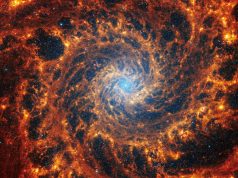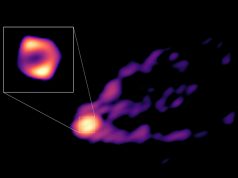WASHINGTON — A sudden outburst of jets from a black hole 8,000 light years from Earth has offered astronomers a rare opportunity to measure the surrounding magnetic field, only to find it weaker than expected.
The results appear to go against our current understanding of black holes that are famous for its intense gravitational pull known to gobble up entire stars and launch streams of matter into space at almost the speed of light, according to a study published Thursday in the U.S. journal Science.
“We weren’t expecting this, so it changes much of what we thought we knew,” said study co-author Stephen Eikenberry, a professor of astronomy in University of Florida’s College of Liberal Arts and Sciences.
On June 15, 2015, astronomers detected a sudden flare from a binary system called V404 Cygni, which contains a 40-mile-wide (64-kilometer-wide) black hole.
They quickly mobilized radio, infrared, optical, and X-ray telescopes to collect data during the two week-long outburst.
It turned out the magnetic energy around the black hole is about 400 times lower than previous crude estimates.
“Our surprisingly low measurements will force new constraints on theoretical models that previously focused on strong magnetic fields accelerating and directing the jet flows,” said Eikenberry.
So far, astronomers are baffled on how “jets” of particles traveling at nearly the speed of light shoot out of black holes’ magnetic fields, while everything else is sucked into their abysses, he said.
Outbursts of small black holes, like the one observed for the study, occur suddenly and are short-lived, said the study.
The 2015 outbursts of V404 Cygni lasted only a couple of weeks. The previous time the same black hole had a similar episode was in 1989.
“To observe it was something that happens once or twice in one’s career,” said study lead author Yigit Dalilar, a doctoral student in University of Florida’s astronomy department. “This discovery puts us one step closer to understanding how the universe works.”









